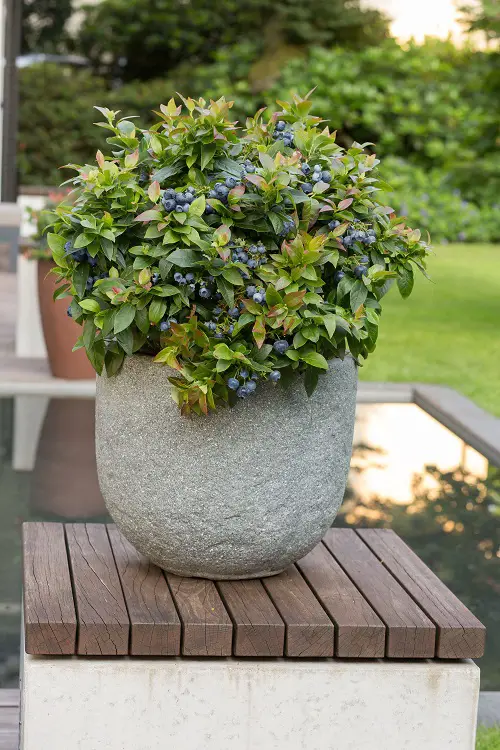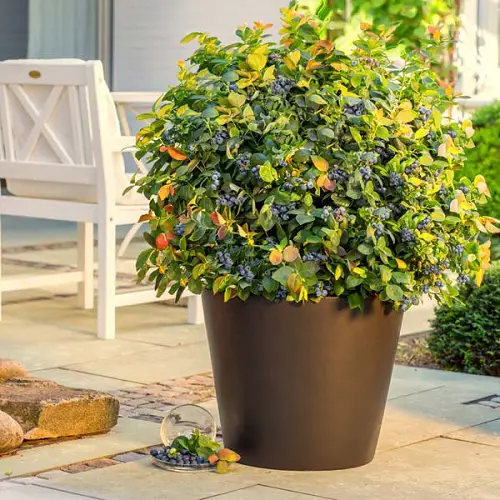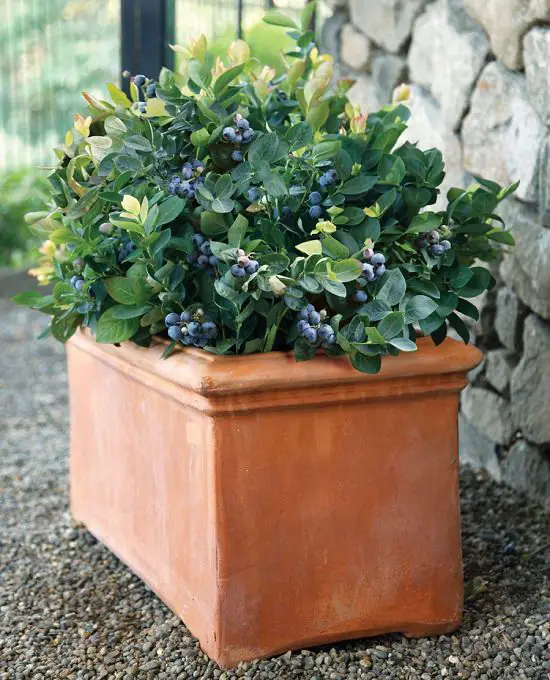Craving delicious fresh berries but don’t have a garden to grow them? Don’t worry! Learn How to Grow Blueberry in Container in a limited space!

Blueberries are suitable for growing in a pot because they have a shallow root system. Growing them in a container is an excellent idea, as they attain a height of just 3-5 feet. So even if you have limited space, you can grow them easily! Learn How to Grow Blueberry in a Container and enjoy them delicious and fresh!
Botanical Name: Cyanococcus
USDA Zones: 3-10
Soil pH: 4.5-5.5
Check out our article on growing Strawberries in containers here
Choosing a Container
The container size also depends on the variety of blueberries you are growing. Large pots, between 16-22 inches deep, are perfect for growing blueberries. You can also go for wine or whiskey barrels, buckets, and large tubs.
Just make sure that they have sufficient drainage holes. Compact varieties like Tophat and Sunshine Dwarf can do well in smaller pots.
Best Blueberry Varieties for Containers
- Pink Icing: With large flavorful berries and beautiful foliage, this variety looks stunning in decorative pots. It grows 3 feet in height and 4 feet in width.
- Patriot Blueberry: Growing berries in abundance, the plant also grows cute white flowers. Attains a height of 3-7 feet with a 3-5 feet spread.
- Peach Sorbet: If you want a beautiful blueberry plant, this variety, with its peach-emerald foliage and abundant blueberries, will amaze you. Grows 1-2 feet high and 2 feet wide.
- Jelly Bean: Like its name, the berries taste like jelly! The plant’s elongated foliage with hints of red also looks gorgeous. Grows a foot high and 2 feet wide.
Learn about Growing Raspberry in Pots here
Growing Blueberries in Pot
Propagation
You can propagate blueberry from seeds and cuttings. However, buying a healthy plant from a nursery is a better option as it will fruit faster!
Planting Time
The best time to plant them is in Spring and Autumn. Spring is a better choice as blueberries will get time to settle down in summer and get stronger before winter arrives, thereby minimizing the risk of freezing.
Requirements for Growing Blueberry

Position
Place the container at a location where it receives a minimum of 6-8 hours of sunlight daily. However, save them from exposing too much to the harsh afternoon sun, as the plants can overheat.
Soil
Blueberries thrive in acidic and well-draining soil. The beauty of growing them in the pot is you can make the best soil mix for the plants!
Fill the pot halfway with regular potting mix and half with acidic potting mix, which you can get from a garden center or online. You can also go with the soil mix meant for Azaleas.
You could also opt for two parts each of shredded coconut coir, sphagnum peat moss with 1 part perlite. Mix them all well, and you’ll have a perfect growing medium!
Watering
You’ll need to water the plant regularly to ensure the soil is always moist. Check the topsoil with your finger; if it feels dry about an inch or two from the surface, water the plant thoroughly.
You can also top-dress with pine bark to help the soil retain its moisture.
Check out the best Strawberry Companion Plants here
Blueberry Care
Fertilizer
A slow-release, acid fertilizer is going to work just fine. Start by applying it four weeks after you have planted the blueberry. Afterward, top dress using a growing medium in the coming spring.
You can also go for a water-soluble liquid fertilizer, such as 10-10-10, once every 1-2 months. Do follow the manufacturer’s recommendation for the dose on the label carefully.
If you want to use organic fertilizers, using a blood meal, fish meal, sphagnum peat, or cottonseed meal is a great idea.
Pruning
Cutting and shaping blueberries are necessary. Sometimes, bushes make weak growth, and this creates little flower buds and lesser fruits. Avoid any serious pruning in the first 3 years; snip only the weak, damaged, and diseased shoots.
Do remember that a well-run bush should have 6-8 main shoots. From the 4th year, you can start trimming the oldest, unproductive stems. The best time to prune is early or mid-spring when new buds appear.
Mulching
As the plant has a shallow root system, mulching the plant is necessary, especially in spring. Using wood bark works well. You can also go for compost, as it goes best with a slow-release fertilizer if you plan to use it.
Frost
Although the shrub is not sensitive to frost, the flowers can be damaged. If there are chances of frost in your area, move the container to a protected place.
Pests and Diseases
Pests and diseases rarely attack blueberries. Just watch out for birds when the berries start to ripen. You can use bird netting to keep the berries safe!
Harvesting and Storage
Between June and August, the berries will be ready to harvest! After these turn blue, wait for a few more days, as the longer berries going to stay on the plant–the sweeter they’ll become.
When the berries are ready, you just have to touch them, and they’ll come right to your hands. Store them in a freezer to enjoy them for a long time!
Health Benefits of Blueberry

- Blueberries are rich in Vitamins, Fiber, and Manganese.
- They also have one of the highest antioxidant levels that helps in the reduction of oxidized LDL in the body.
- The fruits contain potassium and calcium that help in maintaining low sodium levels in the blood.
- The berries also aid in healthy digestion and weight loss.




What about Top Hat blueberries for containers? I saw it listed in a catalog years ago.
Top Hat and Sunshine are good choices for containers. Fill Pots with mini Pine chips, Peat Moss, a few handfuls of Mushroom compost and a good Outdoor Potting mix. 2-4″ of wood mulch to top off. Fertilize in early spring and fall.
Blueberry plants need a lot of water, but they also like sandy, well-draining soil. In other words, they don’t like to be sitting in wa 8 ter, so keep the soil consistently moist, but not soggy.
Blood meal is listed as an appropriate organic fertilizer. The package does not say how much to apply for container grown plants.
although you say pests do not bother, my bush was full of blossoms and I was looking forward to this years harvest. The leaves began to turn brown and the entire bush looks dead. There were spider mites and I sprayed for them. Best advice???
Kathy